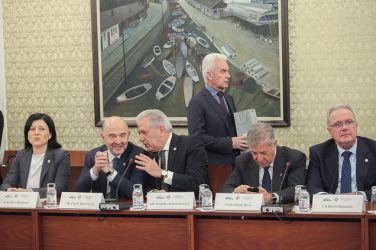France had had a large influx of immigrants in the 20th century, particularly from its former colonies. As in other European countries, immigration has been heavily debated in the past years, and continues to be put on the agenda by the Rassemblement National, for instance. E&M‘s Zoe Perrot-White contextualises the current debate by taking a look at France’s past – and criticises the idea of making France a hostile territory for immigrants.
A professor of mine recently described France as a country with a long history of immigration “qui l’assume pas”. As an immigrant to France myself, this really got me thinking about the country’s turbulent past, and present, relationship with immigration. Today, in France, the question of immigration continues to divide the country in two. Macron’s centrist government is hoping to pull in right-wing voters with the promise of quotas for migrants workers next year, with the President using more openly hostile rhetoric when talking about immigration policy. In September, he told Europe 1 radio, “France cannot host everyone if it wants to host people well. In order to be able to welcome everyone properly, we should not be too attractive a country”. His no-holds-barred interview in October with the ultraconservative publication, Valeurs Actuelles, also made headlines as he gave his thoughts on immigration, communitarianism and, France’s favourite topic, the veil. Far from Macron’s stronghold at the Elysée, France’s battle with immigration is being played out on the streets, with the continuing creation and destruction of temporary migrant camps in the north of Paris. With a bureaucratic system put in place to make things as difficult as possible for the camps’ inhabitants and with police violence a daily occurrence, Paris, like many other towns and cities in France, has truly become a hostile environment for migrants, both documented and undocumented. There are, however, those that push for an acknowledgement of France’s history and legacy of immigration; from Ladj Ly’s highly praised Les Misérables, a stark depiction of life in a Paris banlieue, to Chloé Guerber-Chauzac’s saller-scale documentary En Territoire Hostile, that gives a snapshot of life in Paris’ migrant camps. France cannot hide from its past and, despite a swing to the right with regards to immigration policy, this history of immigration refuses to be silenced. No more so was this evident than in the aftermath of France’s 2018 World Cup victory, with 12 of the 23 French players boasting African ancestry from nine nations across the continent. France’s immigrants exist and they are here to stay.
A brief history
Since the 1890s, France has seen various waves of immigration pass through its borders. The end of the 1800s was the start of free-market liberalism, where immigration was subject to few controls and France’s borders were widely accessible with just a passport or identity card. In 1924, the Société Générale d’Immigration was set up to fill the demand in the French labour market that followed World War I. 40,000 overseas workers were brought over from Southern Europe (Italy and Spain) and also further afield (Poland). This immigration influx of manual labour was repeated in the aftermath of World War II, with an increased number of immigrants coming from many of France’s former colonies, Morocco, Tunisia, Senegal, to name but a few. During the 1960s, France’s North African population would again grow, with the repatriation of the so-called “pieds-noirs” that came after the Algerian War of Independence. The recession of 1975 and the subsequent economic crisis would bring, however, a firming up of borders and the creation of a more “dissuasive” and hostile immigration policy in France. As today’s Europe turns away from free-movement and open borders, France is no different.
An immigrant, or immigré, may arrive in France, receive the correct papers and gain French nationality, yet, for many, they will still remain an immigrant, perhaps not in name but certainly in nature.
France’s policy on immigration has, since the Revolution, been linked to the notion of “assimilation” or, in today’s language, “integration”. The French Constitution of 1958 states that, “France is an indivisible, secular, democratic and social Republic, guaranteeing that all citizens regardless of their origin, race or religion are treated as equals before the law and respecting all religious beliefs”. For an immigrant arriving on French soil, this policy of universalism, whilst sounding like an open door, can be lived as a complete loss of identity. An immigrant, or immigré, may arrive in France, receive the correct papers and gain French nationality, yet, for many, they will still remain an immigrant, perhaps not in name but certainly in nature. INSEE, the French National Institute of Statistics and Economic Studies, states that the “qualité d’immigré est permanente”. An immigrant may take French nationality and have lived in France for most of their life, yet they will never be able to shake this ‘quality’ of immigrant. For their children, this label has become even harder to shake, especially after Sarkozy’s infamous “bande de racailles” insult in 2005: they remain the children of the banlieue with no future. In recent years, there has been a notable shift in the language used to refer to immigrants, from the legally correct term of immigré to the term of migrant, which is neither a legally recognised term nor a definition used by INSEE. We have heard of ‘swarms’ of migrants, ‘invading’ our lands, in a rhetoric style favoured by Marine Le Pen’s Rassemblement National, but also picked up by much of the popular press. In the public imagination, the word ‘migrant’ now comes loaded with a whole host of negative connotations, interesting for a word that was barely used before 2010. Today, being an immigré in France can be difficult at the best of times, but to be labelled as a migrant is to truly live in a “territoire hostile”.
Fortress Europe
Since the 1990s, the northern town of Calais has been home to a revolving series of camps, housing asylum seekers, economic migrants and even refugees. The notorious Sangatte Camp was dismantled in 2002, to be replaced by the even more infamous Jungle, which was widely treated by the international press as a humanitarian disaster. Macron ordered the destruction of the camp in October 2016 and the 6,500 to 8,000 people living there were escorted onto coaches that would take them to one of 280 “centres d’accueil et d’orientation” (CAO) spread across the country. For most, the choice of where they would end up next was completely out of their hands. Once a demand for asylum is registered with the local prefecture, a process that can often take weeks or even months, many migrants will find their requests refused, often on the grounds of the Dublin Regulation. An EU regulation that came into force in 2013, the ‘Dubs Amendment’ “establishes the Member State responsible for the examination of the asylum application”. In reality, this means that the first country a migrant arrives in (and where fingerprints are taken) is the only country they are legally allowed to claim asylum in. In many European countries, this policy has led to the separation of families, with it taking months if not years to reunite them. Out of the 128 775 asylum requests dealt with by the French administration in 2016, a mere 27% were accepted (in comparison to 65% of the 107 710 requests made in Sweden for example).
Out of the 128 775 asylum requests dealt with by the French administration in 2016, a mere 27% were accepted.
After the expulsions in Calais, Paris became the reference point for those wishing to make an asylum claim in France. Of those who did not make the coach, or chose to try another path, many found themselves camping out in tents or makeshift shelters on the Parisian sidewalks. In 2016 there was a total of 31 ‘evacuations’ as a cyclical routine evolved of camps being destroyed and recreated elsewhere in the city. These evacuations were not benign in nature, as documented in Chloé Guerber-Chauzac’s film En Territoire Hostile and Hind Meddeb’s Paris-Stalingrad. Even a quick search on YouTube will bring up clips filmed on personal phones of violent police methods. Methods of dispersion and dissuasion ranged from police raids with dogs during the middle of the night to the CRS’ favourite method of using tear gas to disperse groups. On the 4th November, a total of 3,852 people were evacuated from the Stalingrad camp, moved onto coaches where few were aware of their destination. For those who remained in Paris, a new option was offered by Paris’ Mayor, Anne Hidalgo: the “bulle” at La Chapelle, a new humanitarian centre built for the “accueil des migrants”. The centre, managed by the French authorities along with the humanitarian organisation Emmaus, was tasked with processing the many ‘migrants’ living on the streets to avoid any further camps. The “bulle” was widely criticised by non-government associations for being an underhand tool for the authorities to pinpoint those who had been Dubliné in another EU country and send them back there, regardless of family situations.
France today
The life of a migrant in France today ranges from the precarious to the truly dangerous. In Paris, the camps around the Stalingrad quartier have been closed off, but many camps still exist, pushed towards the northern boundaries of the city. A short walk around Rosa Parks, La Chapelle and Aubervilliers will take you past makeshift camps and migrants, some of them minors or families with small children, looking for a place to spend the night. Police continue to carry out ‘evacuations’, often during the middle of the night, with little to no information given. There are various associations working night and day to find temporary housing solutions, but they are working against a government that refuses to acknowledge the situation in a constructive way. In November, Prime Minister Edouard Philippe, presented a list of 20 measures that will make up the government’s new policy position on immigration. Amongst them, quotas for economic immigrants, a time delay in getting France’s universal medical protection and the creation of three new detention centres across the country. In September, during one of Macron’s “Grands Débats” on immigration, a government spokesperson spoke of the country’s need to “arm itself” against future migration. In 2018, the population of immigrés made up only 9.7% of France’s population, whilst the number of accepted asylum claims still remains low, particularly in comparison to the rest of Europe.
Yet, to go back to where I began, the situation does not go unnoticed. There are those that call out for a different policy on immigration and asylum, one that is better informed by reality, by actual facts, and one that hopes to provide a solution to the situation of a migrant in France today (Migrations, idées reçues et propositions, Movement Utopia). There are also the children of the banlieue, children of immigrants, like Ladj Ly and Kylian Mbappé, the ‘success stories’. Macron famously claimed that he was ‘deeply moved by the accuracy’ of Ladj Ly’s film, a comment not only hypocritical but that will no doubt deepen the feeling that the President is far removed from the immigrant populations of the banlieues. Talking about immigration should not be solely based on talking about success or failure, about us and them; there should be a far greater effort to create a sustainable environment rather than a hostile one. France will continue to be a country of immigration for the foreseeable future, and those in charge would do well to acknowledge this.
Cover photo: Provided by Alatele FR, Scene from the Movie La Haine (1995)







